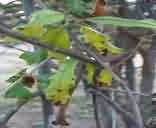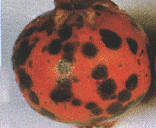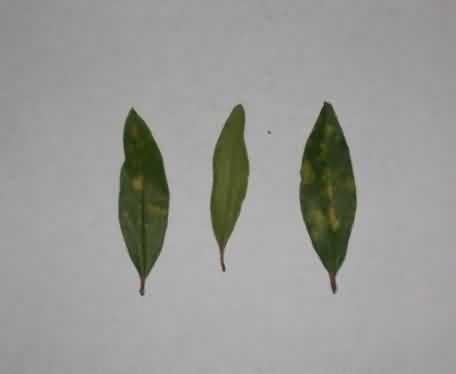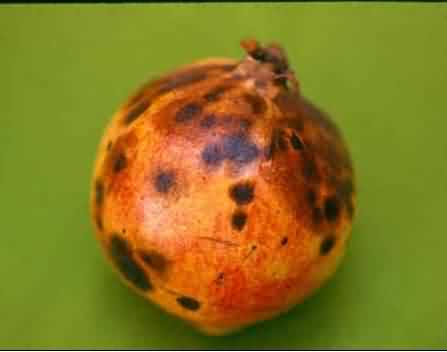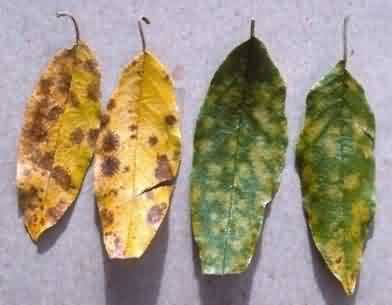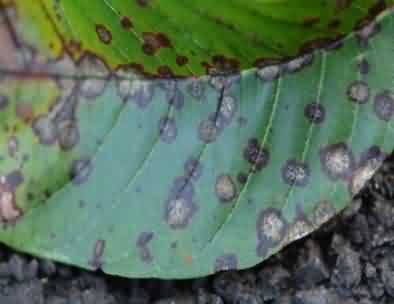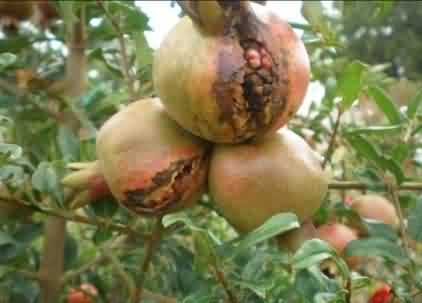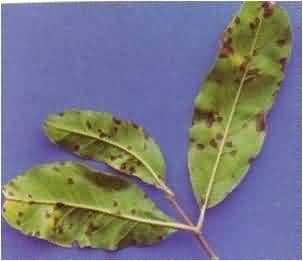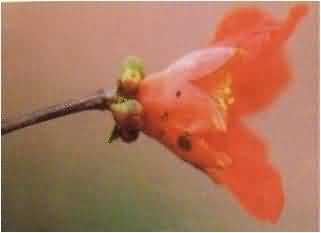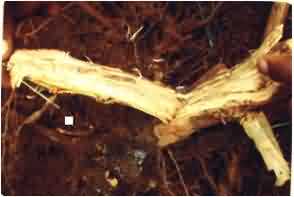अनार की फसल के प्रमुख रोग तथा उनके निदान के तरीके
The pomegranate Punica granatum L. belongs to the family Punicaceae. Pomegranate is cultivated in home gardens especially as a medicinal plant and as a fruit tree. There is no other fruit crop that has high medicinal value compared to that in pomegranate. One of the oldest known fruits found in writings and artefacts of many cultures and religions. Pomegranate is an original native of Persia. This nutrient dense, antioxidant rich fruit has been revered as a symbol of health, fertility and eternal life.
1. Alternaria fruit spot: Alternaria alternata
Symptoms:
- Small reddish brown circular spots appear on the fruits.
- As the disease advances these spots, coalesce to form larger patches and the fruits start rotting.
- The fruits get affected which become pale and become unfit for consumption.
Management:
Cultural:
- All the affected fruits should be collected and destroyed.
Chemical:
- Spraying Mancozeb (0.25%) or Captaf (0.25%) effectively controls the disease.
2. Anthracnose: Colletotrichum gloeosporioides
Symptoms:
- Appears as small regular or irregular dull violet or black leaf spots with yellowish halos.
- Leaves turn yellow and fall out. Symptoms appear on flowers also.
- Both tender and mature fruits develop spots which are initially circular later becoming irregular, brown to dark brown covering the fruit partly or wholly with sunken centres.
- Diseased portions appear with minute, black dots representing acervuli.
The disease is severe during August-September when there is high humidity and the temperature between 20-27ºC.
Primary source of inoculums is infected leaves. Secondary source of inoculums is wind born conidia. It also infects Mango, Guava, and Papaya etc.
Management:
Chemical:
- Carbendazim/ Difenconazole or Thiophanate methyl at 0.25ml/lit sprays at fort-nightly intervals have been found effective.
- Spraying of Difenconazole 25 EC at 1.0 ml/lit or Prochloraz 45 EC at 0.75ml/lit were effective against anthracnose disease.
- Spraying of systemic fungicides namely Hexaconazole @1ml/lit / Thiophanate methyl @ 1g/lit/ Carbendazim @ 1g/lit at 20 days interval is quite effective. Among the contact fungicides Chlorothalonil (2g/l) followed by Mancozeb (2g/l) were more efficacious.
3. Bacterial blight: Xanthomonas axonopodis pv. punicae
Symptoms:
- Appearance of one to several small water soaked, dark coloured irregular spots on leaves resulting in premature defoliation under severe cases.
- The pathogen also infects stem and branches causing girdling and cracking symptoms.
- Spots on fruits were dark brown irregular slightly raised with oily appearance, which split open with L-shaped cracks under severe cases.
Primary source of inoculum is infected cuttings. Secondary source of inoculum is Wind splashed rains.
Continuous/ intermittent rainfall for a longer period, congenial maximum (29.4 to 35.60C) and minimum temperature (19.5 to 27.30C) and relative humidity (63 to 87 %) were found favourable for the development and spread of the disease.
Management
Cultural:
- Wide row spacing
- Selection of disease free seedlings for fresh planting
- Pruning affected branches, fruits regularly and burning
- Bahar should be done in Hasta or Ambe bahar
- Give minimum four month rest after harvesting the fruits
Chemical:
- Before pruning it should be sprayed with 1% Bordeaux mixture
- After Ethrel spraying or defoliation, Paste or smear with 0.5g Streptomycin Sulphate + 2.5g Copper oxy chloride + 200g red oxide per lit of water.
- Spray 0.5 g Streptomycin Sulphate or Bacterinashak +2.5 g Copper oxy chloride per litre of water.
- Next day or another day spray with 1 g ZnSo4 +1 g MgSo4 +1 g Boron +1g CaSo4 per lit of water.
4. Cercospora fruit spot : Cercospora punicae
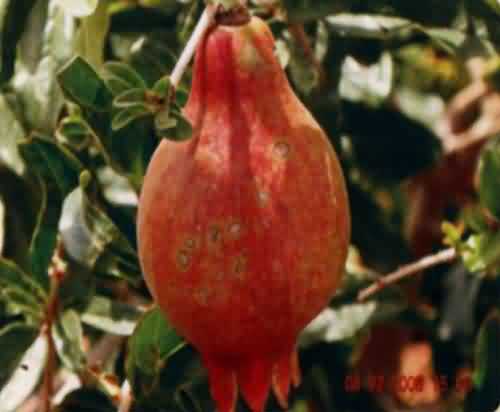 Symptoms:
Symptoms:
- Light zonate brown spots appear on the leaves and fruits. Black and elliptic spots appear on the twigs.
- The affected areas in the twigs become flattened and depressed with raised edge.
- Such infected twigs dry up. In severe cases the whole plant dies.
- Primary source of inoculums is infected leaves, diseased plant debris.
- Secondary source of inoculums is wind born conidia. The disease is serious during September to November.
Management:
Cultural:
- The diseased fruits should be collected and destroyed.
- Pruning and destruction of diseased twigs
Chemical:
- Spray the crop with Hexaconazole 5 EC or Propiconazole 25 EC or Difenconazole 25 EC @ 1 ml / lit.
- Kitazin 48 EC 2 ml / lit or Carbendazim (1g) or Chlorothalonil 75 WP (2.5 g) or Copper oxychloride 50 WP (3 g) per lit.
- Thiophanate methyl / Carbendazim @ 1g / lit were most effective.
- Among the contact fungicides Chlorothalonil @ 2 ml followed by Mancozeb @ 2 g were more efficacious.
5. Cercospora leaf spot: Cercospora punicae
Symptoms:
- Leaf spots are minute, brown with yellow halo.
- Spots are scattered, circular or irregular and become dark brown with age.
- Spots on lower side are sunken with clusters of spore bearing structures hence greyish in colour.
- Minute, circular, black spots appear on sepals of the flower.
- Fruit spots are black, minute and circular on rind.
- When grow old, become large, irregularly circular and depressed presenting an ugly look to the fruits.
Chemical:
- Spray Thiophanate - methyl @ 1 g/l, Carbendazim 1g/l, Hexaconazole 1 ml/l or Propiconazole 1 ml/l for effective control.
6. Wilt of pomegranate: Ceratocystis fimbriata, Fusarium oxysporum
Symptoms:
- Affected plants show yellowing of leaves in some twigs or branches, followed by drooping and drying of leaves. The entire tree dies in few months or a year.
- When affected tree is cut open lengthwise or cross-section, dark greyish-brown coloration of wood is seen.
- Primary source of inoculums is soil and secondary source of inoculums are Conidia, water. Disease is more in heavy soil and increases with soil moisture.
Management:
Cultural:
- Do not allow water to stagnate, try to create drainage facility.
- Do not irrigate for 2-3 days after drenching.
Chemical:
- At initial stage drench 2ml Propiconazole + 4ml Chloropyriphos per litre water solution, drench 8-10 lit of solution per tree.
- If any plant already wilted, drench chemical as per above mentioned, then remove entire plant along with roots and burn it.
- Drench with Formaldehyde @ 25 ml/l.
Authors:
Shantamma1 and Bheemanagouda Patil 2
1Department of Plant Pathology, UAS, GKVK, Bangalore – 560 065, Karnataka
2Department of Plant Pathology, UAS,, Raichur – 584 104, Karnataka
Email:

